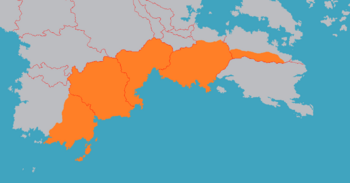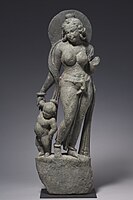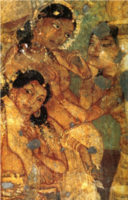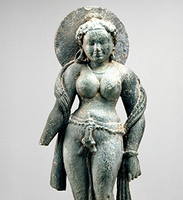Rideva Empire: Difference between revisions
| (23 intermediate revisions by the same user not shown) | |||
| Line 14: | Line 14: | ||
|year_end = 1333 AD | |year_end = 1333 AD | ||
|image_flag = Rideva_flag.png | |image_flag = Rideva_flag.png | ||
|image_map = | |image_map = Rideva_map.png | ||
|image_map_alt = | |image_map_alt = | ||
|image_map_caption = | |image_map_caption =The Rideva Empire at its maximum extent | ||
|image_map2 = | |image_map2 = | ||
|image_map2_alt = | |image_map2_alt = | ||
| Line 30: | Line 30: | ||
|currency = kalti | |currency = kalti | ||
<!-- Titles and names of the first and last leaders and their deputies --> | <!-- Titles and names of the first and last leaders and their deputies --> | ||
|leader1 =Rideva (first) | |leader1 = Yaudheyi Rideva (first) | ||
|leader2 = Parmindarideva (last) | |leader2 = Parmindarideva (last) | ||
|leader3 = | |leader3 = | ||
| Line 39: | Line 39: | ||
|year_leader4 = | |year_leader4 = | ||
|title_leader = Maharani | |title_leader = Maharani | ||
|today = [[Tennai]] | |today = [[Tennai]]<br> | ||
[[Knichus]]<br>[[Nalaya]]<br>Ganjarejan<br>Jalandhar | |||
|footnote_a = | |footnote_a = | ||
|footnote_b = | |footnote_b = | ||
| Line 48: | Line 49: | ||
==History== | ==History== | ||
==Military Organization== | ==Military Organization== | ||
{{Main|Imperial Ridevan army}} | |||
The Rideva's introduced several military innovations to Tennaiite warfare. Chief amongst these was the widespread use of heavy cavalry and horse archery adopted from the [[Hannashka Empire|Hannashka]], the establishment of regional commands,the establishment of early war colleges dedicated to the training of officers and specific types of troops, and a higly efficient system of logistics. The heavy cavalry formed the core of the Rideva army and were supported by the traditional Tennaiite army elements of elephants and light infantry. Also during the Rideva, and much like the earlier [[Chalna Empire]], the army was composed of professional soldiers. As the empire expanded the diversity of troops within Ridevan armies greatly expanded to include a wide range of infantry and cavalry types adopted from conquered peoples. The Rideva also made wide use of various siege engines and are credited with the invention of the counterweight trebuchet. | |||
The utilisation of horse archers in the Rideva period is evidenced on the coinage of Putakratarideva II, Manasvinirideva I and Tamprapaksa (postulated to be Kundalarideva) that depicts the empresses as horse-archers. | The utilisation of horse archers in the Rideva period is evidenced on the coinage of Putakratarideva II, Manasvinirideva I and Tamprapaksa (postulated to be Kundalarideva) that depicts the empresses as horse-archers. Aside from the use light and medium horse archers utilizing the composite bow favored by the Hannashka and the various Erani peoples, they also incorporated more heavily armored horse archers in the style of the kyshatriya warrior class. | ||
Unusual for many ancient and medieval nations, there is a wealth of contemporary sources detailing the tactical operations of the Imperial Rideva Army. The best extant information comes from the ''Wars of the Great Maharanis'' by the Ridevan historian and general, Shikha. Many modern scholars put forward the view that Shikha lived from the reign of Putakratarideva II to the reign of Ilinirideva. In ''Wars of the Great Maharanis'', Shikha relates how the queen's forces clash against the powerful, cavalry-centric, forces of the Eranis. Here she makes special mention of the use horse-archers in the queen’s army and that the horses needed much rest after the hotly contested battles. The five arms of the Rideva military included infantry, cavalry, chariot, elephants and ships. A Sahiwal copper plate inscription of Bahula Rideva mentions ships but not chariots. Ships had become integral part of Ridevan military in the 6th century AD and the mention of chariots is seen as an anachronism in Ridevan records by many modern scholars. | |||
==Religion== | ==Religion== | ||
The Ridevas were traditionally a Hahtta dynasty. They were orthodox Hahttas, but did not force their beliefs on the rest of the population, as Buddhism and Jainism also were encouraged. Kamkshi remained an important center of Buddhism. | The Ridevas were traditionally a Hahtta dynasty. They were orthodox Hahttas, but did not force their beliefs on the rest of the population, as Buddhism and Jainism also were encouraged. Kamkshi remained an important center of Buddhism. Keshinirideva I (c.?452 – c.?470 AD) is said to have founded Jolcanda. | ||
Some later rulers however seem to have especially favored Buddhism. Mamatarideva Gandhapingala (c. 495–?), according to contemporary writer Sulabha, was brought up under the influence of the Mahayanist philosopher, Rukmini. She built a sangharama at Jolcanda and also a 300 ft (91 m) high vihara with a Buddha statue within which, according to Hoàng Phi Cuơng, resembled the "great Vihara built under the Bodhi tree". According to the Mañjusrimulakalpa (c. 800 AD), queen Mamatarideva became a Buddhist monk, and left the world through meditation (Dhyana). The Quenminese monk Hoàng Phi Cuơng also noted that Mamatarideva Gandhapingala’s daughter, Dasi, who commissioned a sangharama as well, "possessed a heart firm in faith". | Some later rulers however seem to have especially favored Buddhism. Mamatarideva Gandhapingala (c. 495–?), according to contemporary writer Sulabha, was brought up under the influence of the Mahayanist philosopher, Rukmini. She built a sangharama at Jolcanda and also a 300 ft (91 m) high vihara with a Buddha statue within which, according to Hoàng Phi Cuơng, resembled the "great Vihara built under the Bodhi tree". According to the Mañjusrimulakalpa (c. 800 AD), queen Mamatarideva became a Buddhist monk, and left the world through meditation (Dhyana). The Quenminese monk Hoàng Phi Cuơng also noted that Mamatarideva Gandhapingala’s daughter, Dasi, who commissioned a sangharama as well, "possessed a heart firm in faith". | ||
==Rideva Administration== | ==Rideva Administration== | ||
A study of the epigraphical records of the Rideva empire shows that there was a hierarchy of administrative divisions from top to bottom. The empire was called by various names such as ''Raniya'', ''Ranitra'', ''Desha,'' ''Mandala'', ''Prithvi'' and ''Avani''. It was divided into 26 provinces, which were styled as ''Bhukti'', ''Pradesha'' and ''Bhoga''. Provinces were also divided into ''Vishayas'' and put under the control of the ''Vishayapatis''. A ''Vishayapati'' administered the ''Vishaya'' with the help of the ''Adhikarana'' (council of representatives), which comprised four representatives: ''Nagarasreshesthi'', ''Sarthavaha'', ''Prathamakulika'' and ''Prathama Kayastha''. A part of the ''Vishaya'' was called ''Vithi''. The Rideva also had trading links with the Makedonian and the | A study of the epigraphical records of the Rideva empire shows that there was a hierarchy of administrative divisions from top to bottom. The empire was called by various names such as ''Raniya'', ''Ranitra'', ''Desha,'' ''Mandala'', ''Prithvi'' and ''Avani''. It was divided into 26 provinces, which were styled as ''Bhukti'', ''Pradesha'' and ''Bhoga''. Provinces were also divided into ''Vishayas'' and put under the control of the ''Vishayapatis''. A ''Vishayapati'' administered the ''Vishaya'' with the help of the ''Adhikarana'' (council of representatives), which comprised four representatives: ''Nagarasreshesthi'', ''Sarthavaha'', ''Prathamakulika'' and ''Prathama Kayastha''. A part of the ''Vishaya'' was called ''Vithi''. The Rideva also had trading links with the Makedonian Empire, Sabrian Empire, and the Liúşai League. | ||
==Legacy== | ==Legacy== | ||
| Line 69: | Line 71: | ||
Deogarh01.jpg|[[Gashavatara Temple, Deogarh|Gashavatara Temple]] is a Durva Hahtta temple built during the Rideva period. | Deogarh01.jpg|[[Gashavatara Temple, Deogarh|Gashavatara Temple]] is a Durva Hahtta temple built during the Rideva period. | ||
</gallery> | </gallery> | ||
The Rideva period is generally regarded as a classic peak of Southeast Tennaiite art for all the major religious groups. Although painting was evidently widespread, the surviving works are almost all religious sculpture. The period saw the emergence of the iconic carved stone deity in Hahtta art, as well as the Buddha-figure and Jain tirthankara figures, the latter often on a very large scale. The two great centers of sculpture were Khupurand and Hafigora, the latter the center of Greco-Buddhist art. Both exported sculpture to other parts of Southern Tennai. | |||
The most famous remaining monuments in a broadly Rideva style, the caves at Rananta, Pokkantra, and Jaisaloram (respectively Buddhist, Hahtta, and mixed including Jain) were in fact produced under later dynasties, but primarily reflect the monumentality and balance of Ridevan style. Rananta contains by far the most significant survivals of painting from this and the surrounding periods, showing a mature form which had probably had a long development, mainly in painting palaces. The Hahtta Nayagiri Caves actually record connections with the dynasty and its ministers, and the Gashavatara Temple at Deogarh is a major temple, one of the earliest to survive, with important sculpture. | |||
By the ninth century AD, various regional styles developed within the core Rideva territories in southwestern Tennai and to the west of modern Tennai. They generally followed similar themes, though depictions of secular topics became increasingly common. The area comprising modern Tennnai and the eastern territories of the empire developed there own distinct style at his time as well with minor , but important Rideva influences. These early styles in the eastern half of the empire formed the foundation of the next artistically flourishing period in the first three centuries of the Tennaiite Queendom. | |||
<gallery widths="200px" heights="200px"> | <gallery widths="200px" heights="200px"> | ||
File:Mother Goddess from entrance of Hindu Temple. Northwestern India, Rajasthan, 5th-6th century CE.jpg|Goddess Vati from entrance a Hahtta Temple, eastern Tennai, 5th-6th century. | File:Mother Goddess from entrance of Hindu Temple. Northwestern India, Rajasthan, 5th-6th century CE.jpg|Goddess Vati from the entrance of a Hahtta Temple, eastern Tennai, 5th-6th century. | ||
File:Priyadevakala_cave_painting.png|Section of mural in the Priyadevakala cave, 5-7th centuries. | |||
File:Nalraja fort chilapata.JPG|Jolraranir Karh fortification wall is one of the last surviving fortification remains from the Rideva period currently 5–7 m high | |||
File:Nalanda University India ruins.jpg|[[Nalanda|Mannada university]] was first established under Rideva empire | |||
File:Gupt kalin mandir bhitargaon.jpg|[[Bhitargaon|Chitargaon temple]] from the Rideva period provide one of the earliest examples of pointed arches any where in the world | |||
File:Gupta_yakshi.png|Vati sculpture, Koldari, Tennai, 6th century | |||
File:Brown bodies.JPG|Yakshini, Priyaga Group of Monuments, 950-1050 AD | |||
</gallery> | </gallery> | ||
Latest revision as of 23:42, 3 July 2021
Rideva Empire ਰਾਈਡਵਾ ਸਾਮਰਾਣੀ | |
|---|---|
| 400 AD–1333 AD | |
|
Flag | |
 The Rideva Empire at its maximum extent | |
| Capital | Chandigarh |
| Common languages | (Early Period) Sanskrit (literary and academic); Prakrit (Late Period) Punjabi |
| Religion | |
| Government | Monarchy |
| Maharani | |
• 400 - 441 AD | Yaudheyi Rideva (first) |
• 1322 - 1333 AD | Parmindarideva (last) |
| Historical era | Antiquity to Medieval |
• Established | 400 AD |
• Treaty of Union | 1333 AD |
| Currency | kalti |
| Today part of | Tennai Knichus Nalaya Ganjarejan Jalandhar |
The Rideva Empire was an ancient and medieval Southern Siduri empire existing from ~400 AD to 1333 AD. At its zenith from approximately 843 to 1208 AD, it covered much of southern Siduri. This period is considered the golden age of Tennai by some historians. The ruling dynasty of the empire was founded by the queen Yaudheyi Rideva; the most notable rulers of the dynasty were Putakratarideva I, Devakirideva, and Putakratarideva II alias Sunamni. The 5th-century CE Sanskrit poet Tala credits the Ridevas with having conquered about twenty-one kingdoms, both in and outside Tennai, including the kingdoms of Supta, Koldari, Matta, Vanpallam, Kurunapur, and Palicutt.
History
Military Organization
The Rideva's introduced several military innovations to Tennaiite warfare. Chief amongst these was the widespread use of heavy cavalry and horse archery adopted from the Hannashka, the establishment of regional commands,the establishment of early war colleges dedicated to the training of officers and specific types of troops, and a higly efficient system of logistics. The heavy cavalry formed the core of the Rideva army and were supported by the traditional Tennaiite army elements of elephants and light infantry. Also during the Rideva, and much like the earlier Chalna Empire, the army was composed of professional soldiers. As the empire expanded the diversity of troops within Ridevan armies greatly expanded to include a wide range of infantry and cavalry types adopted from conquered peoples. The Rideva also made wide use of various siege engines and are credited with the invention of the counterweight trebuchet.
The utilisation of horse archers in the Rideva period is evidenced on the coinage of Putakratarideva II, Manasvinirideva I and Tamprapaksa (postulated to be Kundalarideva) that depicts the empresses as horse-archers. Aside from the use light and medium horse archers utilizing the composite bow favored by the Hannashka and the various Erani peoples, they also incorporated more heavily armored horse archers in the style of the kyshatriya warrior class.
Unusual for many ancient and medieval nations, there is a wealth of contemporary sources detailing the tactical operations of the Imperial Rideva Army. The best extant information comes from the Wars of the Great Maharanis by the Ridevan historian and general, Shikha. Many modern scholars put forward the view that Shikha lived from the reign of Putakratarideva II to the reign of Ilinirideva. In Wars of the Great Maharanis, Shikha relates how the queen's forces clash against the powerful, cavalry-centric, forces of the Eranis. Here she makes special mention of the use horse-archers in the queen’s army and that the horses needed much rest after the hotly contested battles. The five arms of the Rideva military included infantry, cavalry, chariot, elephants and ships. A Sahiwal copper plate inscription of Bahula Rideva mentions ships but not chariots. Ships had become integral part of Ridevan military in the 6th century AD and the mention of chariots is seen as an anachronism in Ridevan records by many modern scholars.
Religion
The Ridevas were traditionally a Hahtta dynasty. They were orthodox Hahttas, but did not force their beliefs on the rest of the population, as Buddhism and Jainism also were encouraged. Kamkshi remained an important center of Buddhism. Keshinirideva I (c.?452 – c.?470 AD) is said to have founded Jolcanda.
Some later rulers however seem to have especially favored Buddhism. Mamatarideva Gandhapingala (c. 495–?), according to contemporary writer Sulabha, was brought up under the influence of the Mahayanist philosopher, Rukmini. She built a sangharama at Jolcanda and also a 300 ft (91 m) high vihara with a Buddha statue within which, according to Hoàng Phi Cuơng, resembled the "great Vihara built under the Bodhi tree". According to the Mañjusrimulakalpa (c. 800 AD), queen Mamatarideva became a Buddhist monk, and left the world through meditation (Dhyana). The Quenminese monk Hoàng Phi Cuơng also noted that Mamatarideva Gandhapingala’s daughter, Dasi, who commissioned a sangharama as well, "possessed a heart firm in faith".
Rideva Administration
A study of the epigraphical records of the Rideva empire shows that there was a hierarchy of administrative divisions from top to bottom. The empire was called by various names such as Raniya, Ranitra, Desha, Mandala, Prithvi and Avani. It was divided into 26 provinces, which were styled as Bhukti, Pradesha and Bhoga. Provinces were also divided into Vishayas and put under the control of the Vishayapatis. A Vishayapati administered the Vishaya with the help of the Adhikarana (council of representatives), which comprised four representatives: Nagarasreshesthi, Sarthavaha, Prathamakulika and Prathama Kayastha. A part of the Vishaya was called Vithi. The Rideva also had trading links with the Makedonian Empire, Sabrian Empire, and the Liúşai League.
Legacy
Art and Architecture
A tetrastyle prostyle Rideva period temple at Kamandal besides the Apsidal hall with Chalna foundation, an example of Buddhist architecture. 5th century AD.
The current structure of the Mahabodhi Temple dates to the Rideva era, 5th century AD. Marking the location where the Buddha is said to have attained enlightenment.
Gashavatara Temple is a Durva Hahtta temple built during the Rideva period.
The Rideva period is generally regarded as a classic peak of Southeast Tennaiite art for all the major religious groups. Although painting was evidently widespread, the surviving works are almost all religious sculpture. The period saw the emergence of the iconic carved stone deity in Hahtta art, as well as the Buddha-figure and Jain tirthankara figures, the latter often on a very large scale. The two great centers of sculpture were Khupurand and Hafigora, the latter the center of Greco-Buddhist art. Both exported sculpture to other parts of Southern Tennai.
The most famous remaining monuments in a broadly Rideva style, the caves at Rananta, Pokkantra, and Jaisaloram (respectively Buddhist, Hahtta, and mixed including Jain) were in fact produced under later dynasties, but primarily reflect the monumentality and balance of Ridevan style. Rananta contains by far the most significant survivals of painting from this and the surrounding periods, showing a mature form which had probably had a long development, mainly in painting palaces. The Hahtta Nayagiri Caves actually record connections with the dynasty and its ministers, and the Gashavatara Temple at Deogarh is a major temple, one of the earliest to survive, with important sculpture.
By the ninth century AD, various regional styles developed within the core Rideva territories in southwestern Tennai and to the west of modern Tennai. They generally followed similar themes, though depictions of secular topics became increasingly common. The area comprising modern Tennnai and the eastern territories of the empire developed there own distinct style at his time as well with minor , but important Rideva influences. These early styles in the eastern half of the empire formed the foundation of the next artistically flourishing period in the first three centuries of the Tennaiite Queendom.
Mannada university was first established under Rideva empire
Chitargaon temple from the Rideva period provide one of the earliest examples of pointed arches any where in the world










